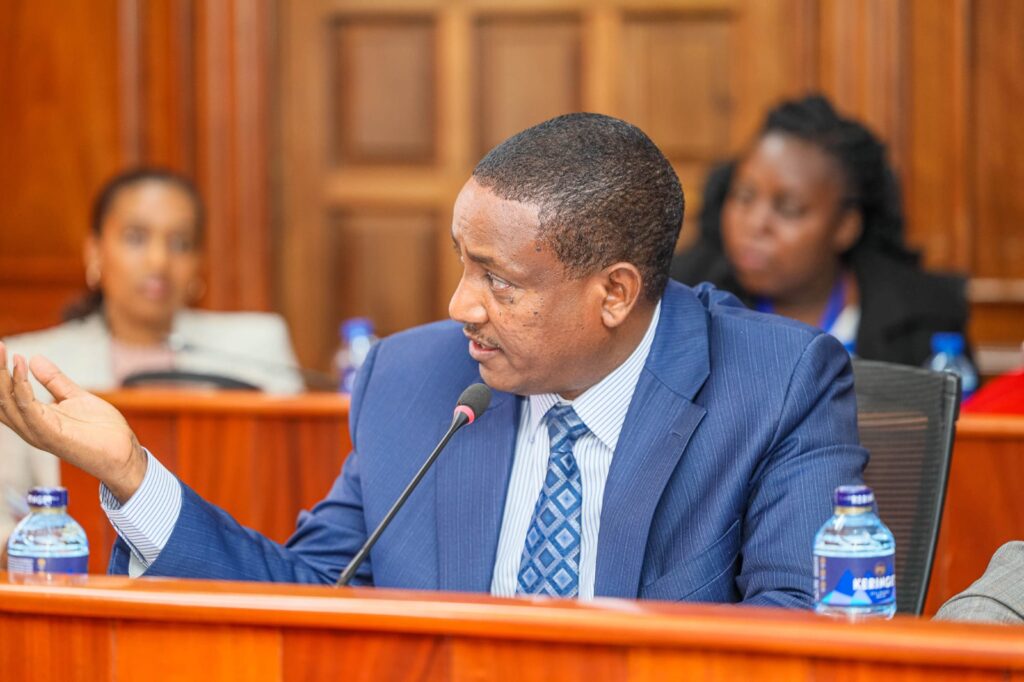Mradi Residents Encroached Industrial Zone, Says NEMA

Director General for NEMA, Mr. Mamo Mamo, appeared before Senate Committee on Energy to deliberate on the tragic incident that occurred on 1st February 2024 in Embakasi, Nairobi City County, where liquid petroleum gas tanker exploded.
The director general said that the National Environment Management Authority uses various environmental assessment tools namely Strategic Environmental Assessment (SEA), Environmental and Social Impact Assessment (ESIA) and Environmental Audit (EA) to process various development applications requests as applicable.
The developmental applications to NEMA are usually processed in line with the provisions of EMCA, 1999 and Environmental (Impact Assessment and Audit) Regulations 2003.
He further told the committee that Section 58 (1) of the Environmental Management and Coordination Act (EMCA),1999 state that “notwithstanding any approvals, permits or license granted under this Act or any other law in force in Kenya, any person, being a proponent of a project, shall, before financing, commencing, proceeding with, carried out, executing or conducting or causing to be financed, commenced, proceeded with, carried out, executed or conducted by any other person any undertaking specified in the 2nd schedule of this Act submit a Project Report to the Authority in the prescribed form, giving the prescribed information and which shall be accompanied by the prescribed fee.”
“Regulation 4 (2) of the Environmental (Impact Assessment and Audit), Regulations, 2003 state that “No licensing Authority under any law in force in Kenya shall issue a license for any project for which an EIA is required under the Act unless the applicant produces to the licensing Authority a license of EIA issued by the Authority under these Regulations”, said the director general.
The director general added that, “This means that the ESIA process precedes the issuance of relevant government permits, licenses and approval documents from various mandated Agencies. As such, ESIA is a pre-authorization tool focusing on the environmental suitability of a proposed project site subject to the authorization and clearance from other lead agencies such as Energy and Petroleum Regulatory Authority (EPRA), Nairobi City County, Directorate of Occupational Health and Safety Services, Kenya Bureau of Standards (KEBS) among others.”
The authority’s management elucidated that the issuance of an ESIA license to a proponent does not absolve the project proponent from their obligations to acquire other applicable permits, licenses and approvals from relevant Agencies before financing, commencing and execution of the proposed project. The ESIA process is kept alive by the ESIA license conditions, which form the basis on which the Authority and other lead agencies monitor the compliance by the proponent.
The committee wanted the authority to explain why the LPG refilling facility was located close to human settlement. The NEMA management explained that the land use/zonation is one among several key aspects that are evaluated during the processing of an ESIA application. The ESIA application by Maxxis Nairobi Energy Ref: NEMA/NRB/PR/5/1/17074 (PSR 31337) for the proposed LPG storage and filling plant was to be located on Plot L.R. No. 9042/146 off North Airport Road.
Special condition no. 5 of the provided Land title registration documents in support for the application indicates that the land and the buildings shall only be used for inoffensive industrial purposes with ancillary offices and stores.
This means that the area is zoned for industrial purposes and other related uses thus this could only mean that the human settlements in the vicinity of the proposed site had encroached into an industrial zone.
The director general said that, “Planning for Land-uses has been and continues to be one of the most challenging aspects of the nexus between environment and planning. To ensure sustainability, the need to restrict incompatible developments within the various sectors such as industrial/residential (human settlement), agricultural/mining/forestry/water resources among others needs to be more economically efficient, aesthetically pleasing, socially and environmentally sustainable.”
The requirements for setting up an LPG filling and storage facility are given by EPRA which is the mandated regulatory body on petroleum products.
NEMA’s role is to process the submitted ESIAs to ascertain the environmental suitability of a proposed site in consultation with the relevant lead agencies in this case EPRA which is the lead agency for permitting and licensing of LPG storage and filling facilities.
The ESIA license is a pre-requisite for obtaining approvals in the storage and filling of LPG in bulk from EPRA as per their set requirements.
The Authority draws its power to enforce from Environmental Management and Coordination Act, 1999 in case of breach of the ESIA license conditions.
The Authority elucidated to the committee the various enforcement actions to remedy environmental offenses as follows:
Issuance of Improvement Notices – served by an Environmental Inspector requiring the owner or operator of facility to cease any activities deleterious to the environment and to take appropriate remedial measures, including the installation of new plant and machinery if necessary, within such reasonable time as the Director-General may determine.
Issuance of Restoration Orders – served by an Inspector of the Authority to require the person on whom it is served to restore the environment as near as it may be to the state in which it was before the taking of the action which is the subject of the order; or prevent the person on whom it is served from taking any action which would or is reasonably likely to cause harm to the environment.
Issuance of closure orders – Issued to order the immediate closure of any manufacturing plant or other establishment or undertaking which pollutes or is likely to pollute the environment contrary to the provisions of EMCA and to require the owner or operator of such establishment or undertaking to implement any remedial measures that the environmental inspector may direct.
Prosecution – The Authority through its inspectors, with an arrest warrant and the assistance of a police officer, is allowed to, arrest and prosecute any person whom it reasonably believes has committed an offence under EMCA.
The Authority proposes that the land use planning/zonation laws are reviewed to do away with piece meals change of users that allows for the encroachment of incompatible land uses within a defined zone to avoid potential conflicts and avert possible disasters, the proposed new developments should be anchored to the approved County Spatial Plans and the Authority has introduced a requirement for the licensed proponent to notify NEMA in writing upon ground breaking for monitoring of the issued conditions.
Finally, NEMA told the committee that the responsibility of a project proponent towards the environment does not end with the issuance of an ESIA license. The ESIA process is kept alive through the ESIA license conditions and which form the premise on which the Authority and other lead agencies monitor the compliance by the proponent for appropriate corrective and/or enforcement action.
The Authority is committed in ensuring that appropriate environmental and social safeguards are put in place for a safe, clean, healthy and sustainable development of any project.




